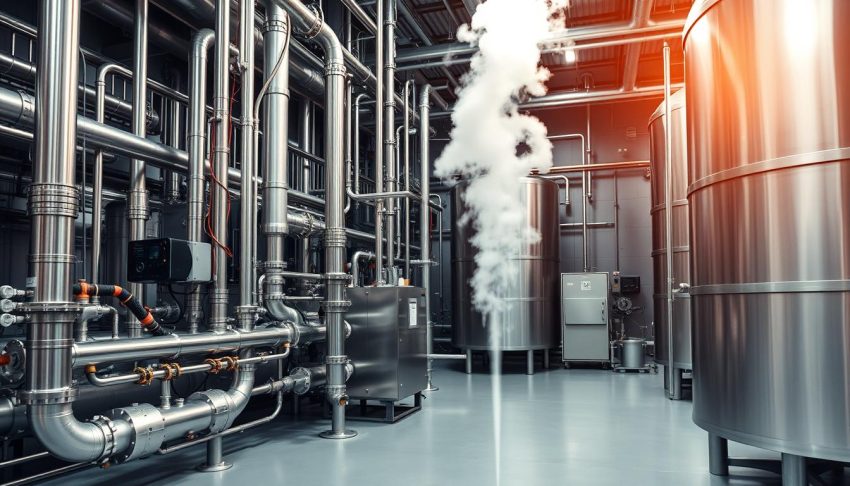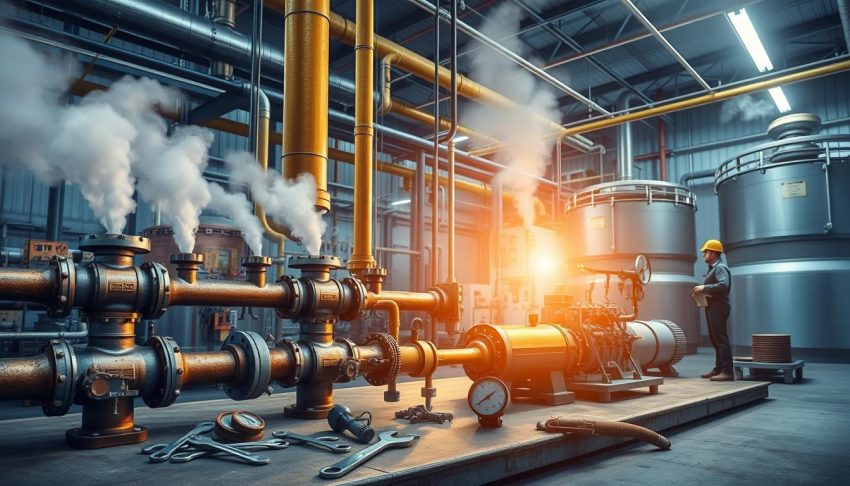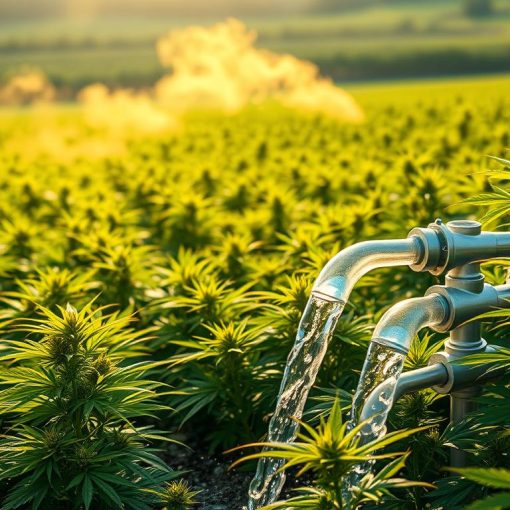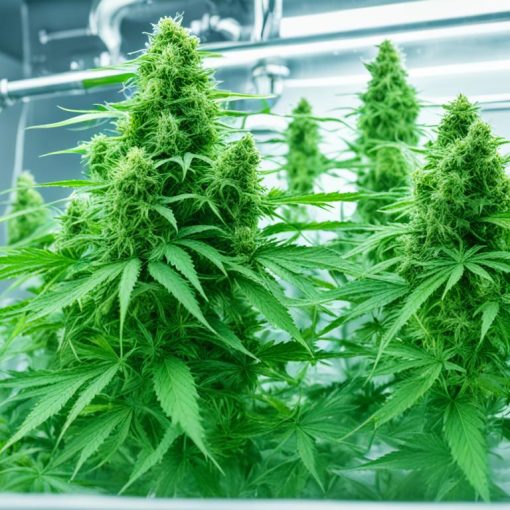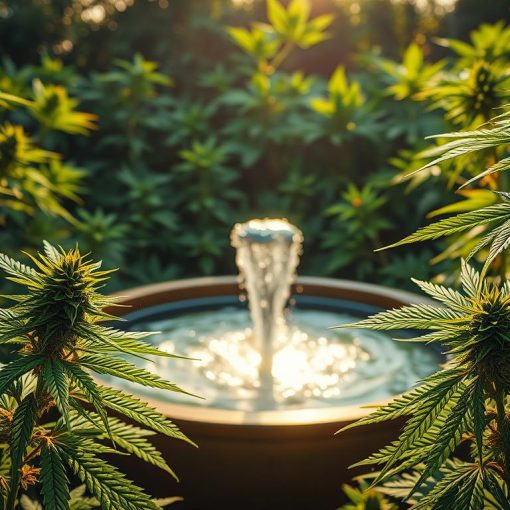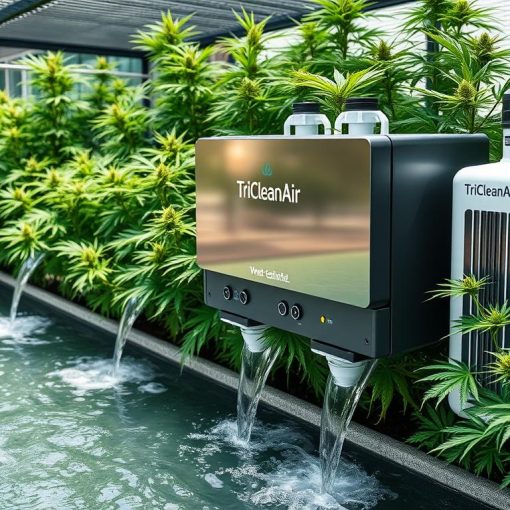In today’s fast-paced business world, companies are always looking for ways to improve, cut costs, and be more eco-friendly. One effective strategy is using condensate recovery systems. This method helps businesses use their own energy better, saving money and being kinder to the planet.
By catching and using the condensate from different industrial and commercial processes, companies can get a lot more efficient. This approach cuts down on energy use and water waste. It’s a smart way to save money and protect the environment.
Key Takeaways
- Condensate recovery is a strategic approach that enhances energy efficiency and reduces operational costs.
- By capturing and reusing condensate, organizations can minimize water consumption and achieve significant cost savings.
- Condensate recovery systems offer a comprehensive solution for process optimization and sustainable operations.
- Implementing a condensate recovery system can lead to substantial financial and environmental benefits for organizations.
- TriCleanAir offers ready-to-install Condensate Recovery Skids for facilities of all sizes, enabling a seamless integration of this innovative technology.
What is Condensate Recovery?
Condensate recovery is a process that collects, treats, and reuses the steam or vapor from various industrial and commercial settings. This process helps reduce the need for fresh water and cuts down on energy used to make new steam or heat.
Understanding the Basics
When steam or vapor cools, it turns back into a liquid, called condensate. Systems for condensate recovery grab this valuable resource. It’s full of heat energy and can be reused to make systems more efficient.
Benefits of Implementing a System
- Improved energy efficiency by recovering and reusing the heat energy in the condensate
- Reduced water consumption by recycling the condensate instead of using fresh water
- Lower operational costs through decreased water and energy expenses
- Contribution to sustainable practices and environmental stewardship
TriCleanAir offers condensate recovery skids for any facility size. This makes it easy for companies to start a full condensate reclamation system and see the benefits.
“Implementing a condensate recovery system can be a game-changer for organizations looking to improve their energy efficiency and reduce water consumption and costs.”
| Metric | Potential Savings |
|---|---|
| Energy Consumption | Up to 20% reduction |
| Water Consumption | Up to 30% reduction |
| Operational Costs | Up to 15% reduction |
Improving Energy Efficiency with Condensate Recovery
These systems are key to boosting energy efficiency. They help organizations cut down on energy use and costs. By using the heat in condensate, these systems reduce the need for new steam or heat. This leads to big savings.
The process is simple but powerful. Steam used in industries condenses back into liquid, called condensate. This liquid still has a lot of heat that can be used again. By using this heat, the need for making new steam or heat goes down. This means better energy use and less pollution.
| Energy Efficiency Metric | Improvements |
|---|---|
| Steam System Optimization | Up to 20% improvement in steam system efficiency |
| Heat Recovery | Potential to recover up to 80% of the heat energy in condensate |
| Greenhouse Gas Emissions | Reduction of up to 10% in facility-wide emissions |
Using a good condensate recovery system makes things more efficient and helps with being green. It cuts down on energy use and emissions. This shows a company cares about the planet and meets green rules.
“Condensate recovery is a cornerstone of sustainable steam system management, enabling organizations to optimize their energy use and reduce their environmental impact.”
TriCleanAir is a top name in water treatment solutions. They have pre-made and custom systems for different places. Their know-how in making steam systems better and recovering heat helps companies save energy and money with reliable systems.
Reducing Water Consumption and Costs
Condensate recovery systems are key to saving water and cutting costs. They take back the condensate from various industrial and commercial processes. This helps save fresh water and is good for the environment through water conservation. It also leads to big cost savings by lowering the costs of getting, treating, and getting rid of water.
How Condensate Recovery Conserves Water
Condensate from systems like steam boilers and HVAC can be used again. It can be used as makeup water for boilers, for cooling towers, or for watering plants. This water is clean and free of harmful stuff, making it a great resource. It helps cut down on wastewater reduction and water consumption.
Calculating Potential Savings
Using a condensate recovery system can save a lot of money. For instance, a place that gets 80% of its condensate back and uses it again can cut its water costs by up to 80%. It also means less money spent on treating and getting rid of water. This leads to more cost savings and better sustainability efforts. A good condensate recovery system brings big environmental impact and financial gains.
| Water Consumption Reduction | Cost Savings |
|---|---|
| Up to 80% | Significant reduction in water, treatment, and disposal expenses |
“Condensate recovery is a game-changer in the quest for water conservation and cost-effective operations. By reclaiming this valuable resource, organizations can significantly reduce their environmental footprint while improving their bottom line.”
Condensate Recovery Systems: An Overview
Condensate recovery systems are key to saving energy and cutting costs in many industries. They capture, treat, and reuse the condensate from various industrial and commercial processes.
Components and Functionality
These systems have several important parts that work together for better efficiency and performance. They include:
- Condensate collection tanks: These tanks collect the condensate as it is made.
- Pumps: These pumps move the recovered condensate through the system.
- Valves: Valves control how much and where the condensate flows.
- Piping: This piping carries the condensate from the collection point to where it’s needed.
The setup and how a condensate recovery system works can change based on the industry and goals. Some systems also have extra features like water treatment, monitoring, and control to work better and meet rules.
“Using a well-designed condensate recovery system can save a lot of energy and money. It’s a smart choice for businesses of all sizes.”
These systems help save water, reduce energy use, and lower costs. This makes operations more sustainable and efficient. It also helps businesses make more money and be better for the environment.
Choosing the Right Condensate Recovery System
Choosing the right condensate recovery system is key to getting the most out of it. Companies need to think about how much and what kind of condensate they have. They should also consider their process requirements, and how much energy efficiency and cost-effectiveness they want. Talking to experts can help pick the best system for their needs and goals.
When picking a condensate recovery system, look at its system design. It should fit the specific needs of the application. Important things to think about include:
- Condensate volume and quality: The system must be the right size to handle the expected amount of condensate and can deal with any dirt or contaminants.
- Process integration: The system should work well with the current setup and production steps, causing little disruption.
- Automation and controls: Having automated parts and smart controls can make the system more energy efficient and easier to use.
- Maintenance and serviceability: The system should be easy and affordable to keep up, ensuring it works well for a long time.
By looking at these things, companies can find a condensate recovery system that boosts energy efficiency, cost-effectiveness, and meets their process requirements. TriCleanAir offers Condensate Recovery Skids for all kinds of facilities, making it easier to choose and set up the system.
“Investing in the right condensate recovery system can lead to big savings and environmental benefits for any company.”
Condensate Recovery for Industrial Applications
Industrial places like manufacturing, food and drink making, chemical making, and power generation use condensate recovery systems. These systems help save valuable process steam condensate. This leads to big energy savings and cuts costs.
Common Use Cases
Condensate recovery systems are used a lot in industrial places for different needs:
- In manufacturing, they recycle condensate from process steam. This reduces the need for fresh water and cuts energy use.
- Food and drink places use them to get back heat energy and reuse water for cleaning and other processes.
- Chemical plants use these systems to get back high-purity condensate. This can be put back into their production.
- Power plants use them to make their steam-driven turbines more efficient and lower water treatment costs.
Optimizing System Design
Designing and putting together industrial condensate recovery systems is key for the best performance and benefits. Things like process flow, condensate quality, system layout, and energy needs must be thought over carefully. This makes sure the system fits the needs of the industrial place.
TriCleanAir is a top provider of condensate recovery solutions. They offer pre-engineered and ready-to-install Condensate Recovery Skids. These are made to fit into various industrial processes easily. This means quick setup and right away, energy and cost savings.
| Industry | Condensate Recovery Benefits |
|---|---|
| Manufacturing | Reduced energy consumption, water usage, and wastewater treatment costs |
| Food and Beverage | Reclaimed heat energy, reused water for cleaning and process applications |
| Chemical Production | Recovery of high-purity condensate for reintroduction into production processes |
| Power Generation | Improved turbine efficiency and reduced water treatment expenses |
Condensate Recovery for Commercial Buildings
Condensate recovery is not just for big factories; it’s great for commercial buildings too. Places like offices, hospitals, and schools can use it to save water, cut energy costs, and be more green.
Big commercial buildings have HVAC systems and dehumidifiers that make a lot of condensate water. Instead of throwing it away, it can be used for things like cooling tower water, watering plants, or even drinking water, if it’s treated right.
Adding a condensate recovery system to a commercial building saves a lot of water and energy. It cuts down on the need for city water, saving money and helping the planet. It also uses less energy to heat or cool the water, which is a big win.
Putting a condensate recovery system in a building’s HVAC systems makes it more efficient and green. It shows a building cares about the environment and lowers its carbon footprint.
TriCleanAir offers easy-to-install Condensate Recovery Skids for any commercial size. This lets building managers quickly add this smart tech. By using condensate recovery, buildings save water, cut costs, and lead by example for others.
“Condensate recovery is a simple yet highly effective way for commercial buildings to conserve water, save energy, and demonstrate their commitment to sustainability.”
As more businesses see the perks of condensate recovery, it’s becoming more popular. This move towards sustainability is making the future of buildings brighter.
Integration and Installation Considerations
When adding a condensate recovery system, making it fit with what’s already there is key. Good project planning and careful installation are vital. This ensures a smooth start and gets the most out of the new system. Talking to experts can help, guiding you through the challenges and boosting the operational efficiency of the condensate recovery system.
Seamless Integration with Existing Systems
Adding a condensate recovery system to an existing infrastructure needs a careful plan. It must work well with the current setup, causing little disruption. Solutions tailored to your needs are often required for a successful blend that brings out the best in the condensate recovery tech.
- Check if the condensate recovery system fits with what you already have
- Spot potential problems and plan how to fix them
- Work with facility managers and tech experts for a smooth setup
- Provide training for staff on the new system
With a strategic view on installation and integration, adding a condensate recovery system can be done smoothly. This brings lasting benefits and improves your energy efficiency.
Maintenance and Monitoring Condensate Recovery Systems
Keeping your condensate recovery system in top shape is key to its performance and life span. Regular checks, upkeep, and watching the system closely can spot and fix problems early. This ensures it keeps saving energy and cutting costs over time.
Having a detailed plan for maintenance and watching the system can make it work better. Here are some important steps to follow:
- Scheduled Inspections: Check the system parts like pumps, valves, and heat exchangers often. Look for wear, leaks, or signs of trouble.
- Preventive Maintenance: Do regular cleaning of filters, check for scale, and adjust sensors. This keeps the system running well.
- Performance Monitoring: Keep an eye on how the system is doing. Watch the recovery rates, energy use, and water saved. This helps spot any problems.
- Troubleshooting and Optimization: Fix any issues or inefficiencies quickly. Make changes or updates as needed to improve how the system works.
Putting time and effort into looking after and watching your condensate recovery system pays off. It keeps it running efficiently for a long time. This way, you get the most out of this energy-saving tech.
“Proper maintenance and monitoring are the keys to unlocking the full potential of your condensate recovery system.”
| Maintenance Task | Frequency | Benefits |
|---|---|---|
| Inspect system components | Monthly | Identify and address issues early |
| Clean filters and strainers | Quarterly | Ensure optimal flow and performance |
| Check for scale buildup | Bi-annually | Prevent reduced heat transfer efficiency |
| Calibrate sensors and controls | Annually | Maintain accurate system monitoring |
Regulatory Compliance and Sustainability
Using a condensate recovery system boosts efficiency and saves money. It also helps meet legal standards and shows a company cares about the environment. By using less water, energy, and cutting down on greenhouse gases, it supports environmental efforts.
Meeting Environmental Standards
Condensate recovery systems are key for following environmental laws. They use less freshwater, create less wastewater, and use less energy. These are important for water management, carbon footprint reduction, and corporate social responsibility.
With a condensate recovery system, companies show they care about the planet. This makes them look good in the public eye and helps their brand. It also meets legal needs and boosts their image as eco-friendly.
| Regulatory Compliance Benefit | Condensate Recovery Impact |
|---|---|
| Water Conservation | Reduced freshwater withdrawal and wastewater discharge |
| Energy Efficiency | Lower energy consumption for heating and cooling |
| Greenhouse Gas Emissions | Decreased carbon footprint through reduced energy use |
| Corporate Social Responsibility | Demonstration of environmental stewardship and sustainability |
Investing in a condensate recovery system helps companies work better and save money. It also helps the environment, making them ready for regulatory compliance and boosting their social responsibility.
Condensate Recovery: A Wise Investment
Putting money into a condensate recovery system is a smart move. It’s cost-effective and brings a great return on investment (ROI). This is thanks to better operational efficiency and long-term savings.
The cost of starting a condensate recovery system is quickly paid back. It saves a lot of energy and water. This means lower utility bills. So, you see a good return on investment soon.
Condensate recovery is also good for the planet. It uses less water and energy. This cuts down on carbon emissions and helps with corporate social responsibility. It’s a big plus for companies wanting to show they care about the environment.
For companies looking to get better at what they do and make more money, a condensate recovery system is a smart choice. It’s cost-effective, saves money over time, and is good for the planet. This makes it a key investment for boosting profits and supporting green efforts.
“Condensate recovery systems are a smart investment that can deliver significant cost savings and environmental benefits for organizations of all sizes.”
Conclusion
The benefits of condensate recovery are clear. It boosts energy efficiency, cuts costs, and supports sustainability in many industries. By using a good condensate recovery system, companies can make their processes better, lessen their environmental footprint, and set themselves up for long-term success.
TriCleanAir is a trusted name in condensate recovery solutions. They offer ready-to-use skids for facilities of all sizes. Their expertise and commitment to top-notch technology help businesses easily add condensate recovery to their operations. This approach helps unlock the full benefits of process optimization.
As companies face new challenges in being efficient and caring for the environment, the importance of condensate recovery will keep growing. By adopting this effective solution, leaders can make real improvements. They can help create a more sustainable future and stand out as leaders in their fields.

